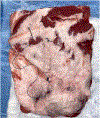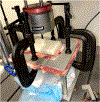A Biomechanical Analysis of Prophylactic Mesh Reinforced Porcine Laparotomy Incisions
- PMID: 35617785
- PMCID: PMC9580392
- DOI: 10.1016/j.jss.2022.04.058
A Biomechanical Analysis of Prophylactic Mesh Reinforced Porcine Laparotomy Incisions
Abstract
Introduction: Research indicates that prophylactic mesh may help prevent incisional hernia after laparotomy, but best practice patterns in these situations are still evolving. Here, we compare the failure loads (FLs) and biomechanical stiffness (BMS) of 35 porcine abdominal wall laparotomy incisions reinforced with meshes of various widths and fixation distances using biomechanical testing.
Methods: In each specimen, a 10-cm incision was made and closed using continuous 1-0 Maxon suture. Specimens were randomized to mesh width (none, 2.5 cm, 3 cm, 4 cm, 6 cm, 8 cm) and tack separation (1.5 cm, 2 cm apart) and the meshes secured in an onlay fashion. Cyclic loads oscillating from 15 N to 140 N were applied to simulate abdominal wall stress, and the specimens subsequently loaded to failure. FLs (N) and BMS (N/mm) were comparatively analyzed.
Results: All specimens failed via suture pull-through. FLs and BMS were lowest in specimens with suture-only (421.43 N; 11.69 N/mm). FLs and BMS were significantly higher in 4-cm mesh specimens (567.51 N) than those with suture, 2.5-cm, and 3.0-cm mesh (all P < 0.05). FLs in specimens with a greater number of tacks were consistently higher in meshes of similar sizes, although these did not reach significance.
Conclusions: A 4-cm mesh reenforcement was superior to suture-only and smaller meshes at preserving strength in laparotomy closure in a porcine model but larger meshes (6 cm, 8 cm) did not provide an additional benefit. Meshes with more fixation points may be advantageous, but additional data are needed to make definitive conclusions.
Keywords: Hernia; Laparotomy; Mesh width; Prevention; Prophylactic mesh placement.
Copyright © 2022 Elsevier Inc. All rights reserved.
Conflict of interest statement
Disclosure
Dr John P. Fischer reports having received consulting fees from Becton Dickinson, Integra, Gore and Baxter. The remaining authors have no conflicts to disclose.
Figures











References
-
- Nguyen MT, Berger RL, Hicks SC, et al. Comparison of outcomes of synthetic mesh vs suture repair of elective primary ventral herniorrhaphy : a systematic review and meta-analysis. JAMA Surg. 2014;149:415–421. - PubMed
-
- Mathes T, Walgenbach M, Siegel R. Suture versus mesh repair in primary and incisional ventral hernias: a systematic review and meta-analysis. World J Surg. 2016;40:826–835. - PubMed
-
- Luijendijk RW, Hop WCJ, Van Den Tol MP, et al. A comparison of suture repair with mesh repair for incisional hernia. N Engl J Med. 2000;343:392–398. - PubMed
-
- Borab ZM, Shakir S, Lanni MA, et al. Does prophylactic mesh placement in elective, midline laparotomy reduce the incidence of incisional hernia? A systematic review and meta-analysis. Surg (United States). 2017;161:1149–1163. - PubMed
Publication types
MeSH terms
Grants and funding
LinkOut - more resources
Full Text Sources

